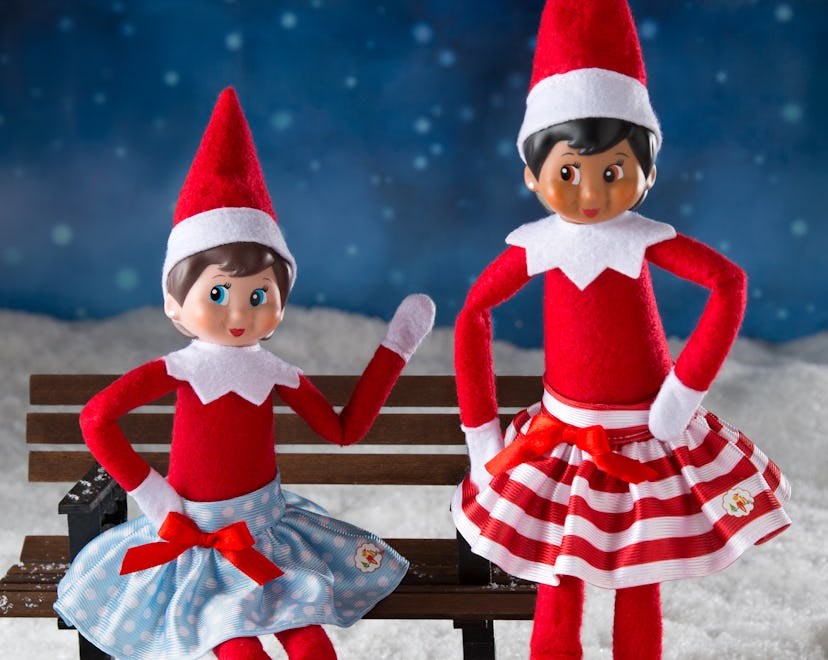The Elf on the Shelf

What Is The Meaning Behind Elf On The Shelf?
The creator of the holiday tradition shares how the elves became and what it means to her.
You've likely seen or heard about The Elf on the Shelf, aka that Scout Elf that descends upon households with children throughout the month of December. But did you know that the Elf actually originated with a book authored by a mother-and-daughter duo to share a tradition they'd had in their house for years? In fact, there's a lot most of us don't know about the meaning behind The Elf on the Shelf and how it became a popular holiday hallmark. And who better to share that story than the creators of The Elf on the Shelf themselves?
Who Created The Elf On The Shelf?
In 2005, Carol Aebersold and her daughter Chanda Bell co-authored the book The Elf on the Shelf: A Christmas Tradition, a tale about Santa’s Elf helpers who visit homes to observe childrens’ pre-holiday behavior. Now the books are sold alongside an elf doll, and a kit that can help you create various scenes for your adopted elf, as the character is meant to return nightly to the North Pole then reappear every morning in different spots around your abode. A chair, booties, and a swing are just a few of the props you can buy for your elf to make its magic come true in your home.
While now there are TV shows, movies and social media ideas to help you enjoy and make the most out of your Scout Elf’s yearly visit, Bell said the character started as a small, family holiday tradition when she was a child. In an interview with Romper, Bell explained, "My mom had an elf from childhood. From the second I can remember, my mom would tell us this was the elf from the North Pole."
Bell recalls she used to imagine what the North Pole might look like, and what the Elf was up to when he flew back to report to Santa every night. "It was the most magical thing I could imagine," she says. The family elf was such a part of their yearly holiday that Bell was surprised to find out that the elf tradition wasn't universal. "When I was growing up I didn't realize other kids didn't have the elf in their homes!"
Bell was a middle school teacher for six years before taking time out to stay home and care for her kids. After a few years, she started working for her dad part-time, which is when she saw the old Christmas Elf (literally sitting on a shelf) and had an idea. Her mom had been going through a tough time with an empty nest, and the idea to write a children's story was "something we could do together and to give my mom something else to think about."
Little did they know that within a decade, the Elf on the Shelf would become a household tradition around the world, shared by celebrities like Kelly Clarkson and Busy Philipps. Today, it seems to be more uncommon to find families who have not adopted an elf into their holiday routine.
What’s The Intended Meaning Behind The Elf On The Shelf?
Its meaning and legacy may vary depending on whom you ask. This story is hardly confined to the pages of a book, as each elf, literally, takes on a life of its own as it becomes a member of a household. And it can be so much fun to stage daily scenes with your family’s elf, and make it a part of your traditions. But on the flip side, the new nightly responsibilities it brings have caused anxiety for some caregivers. And even scholars have weighed in on the phenomenon, wondering if the additional pressures of tending to this elf are worth the work, and if children are feeling pressure, too, from the watchful (spying?) eyes of these little dolls. The annual discussions around the elf’s risks, rewards, and even its shelf-life can be serious, and seriously funny.
Though for Bell, the goal for the Elf has remained the same. With writing The Elf on the Shelf: A Christmas Tradition, Bell and her mother hoped to remind families of the true values of the Christmas season: joy, hope, faith, and a little magic. They were also hoping to help parents and kids interact in new ways — and it's safe to guess there weren't too many families with elves participating in marshmallow snowball fights before the book was published!
But more than the international success, Bell says the stories she hears from families, especially those with kids with disabilities who’ve particularly latched onto the magic of the Elf, is how she really values the story’s success. "Moments like that, you realize how touching and how big this is."
This article was originally published on